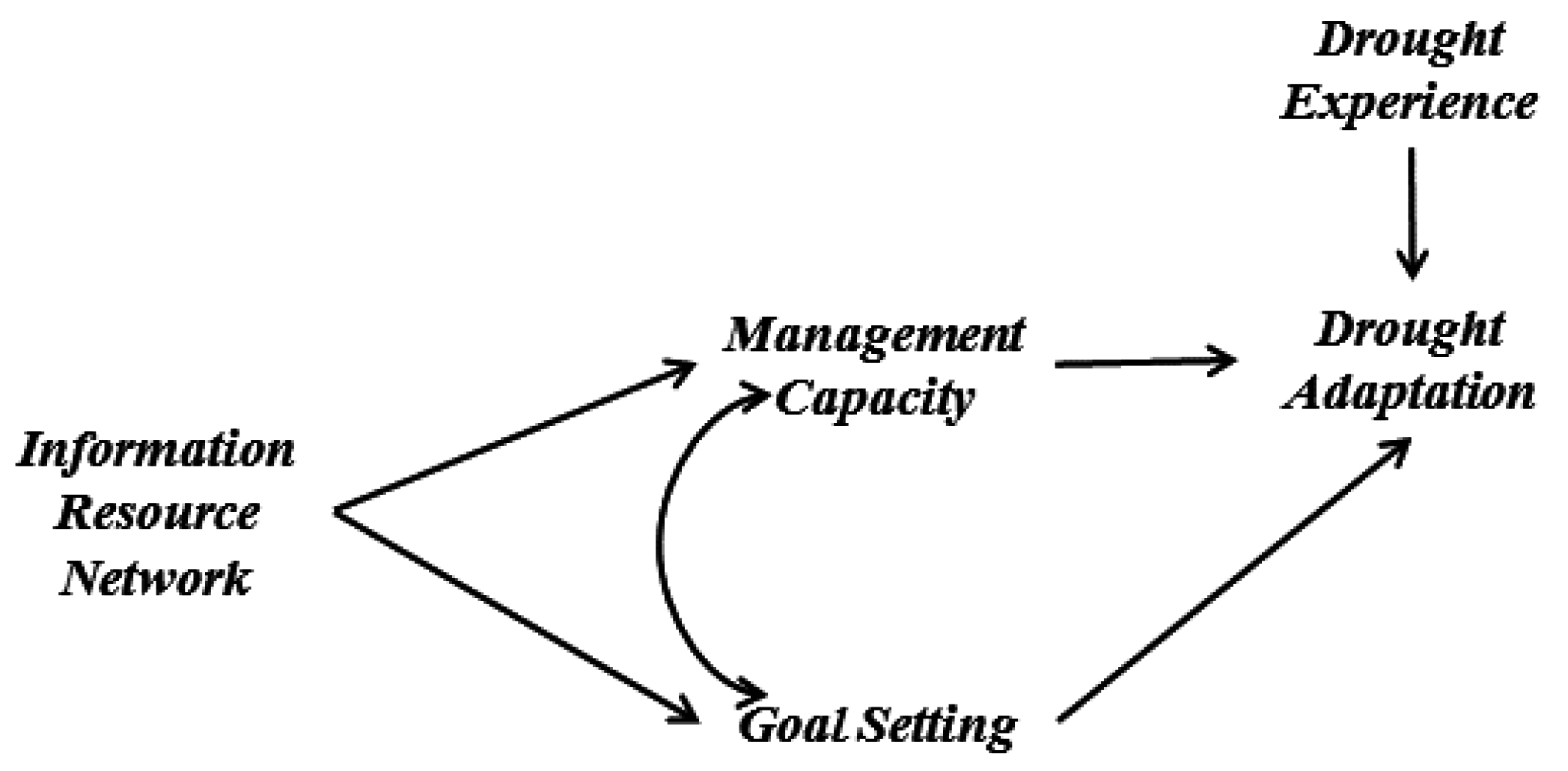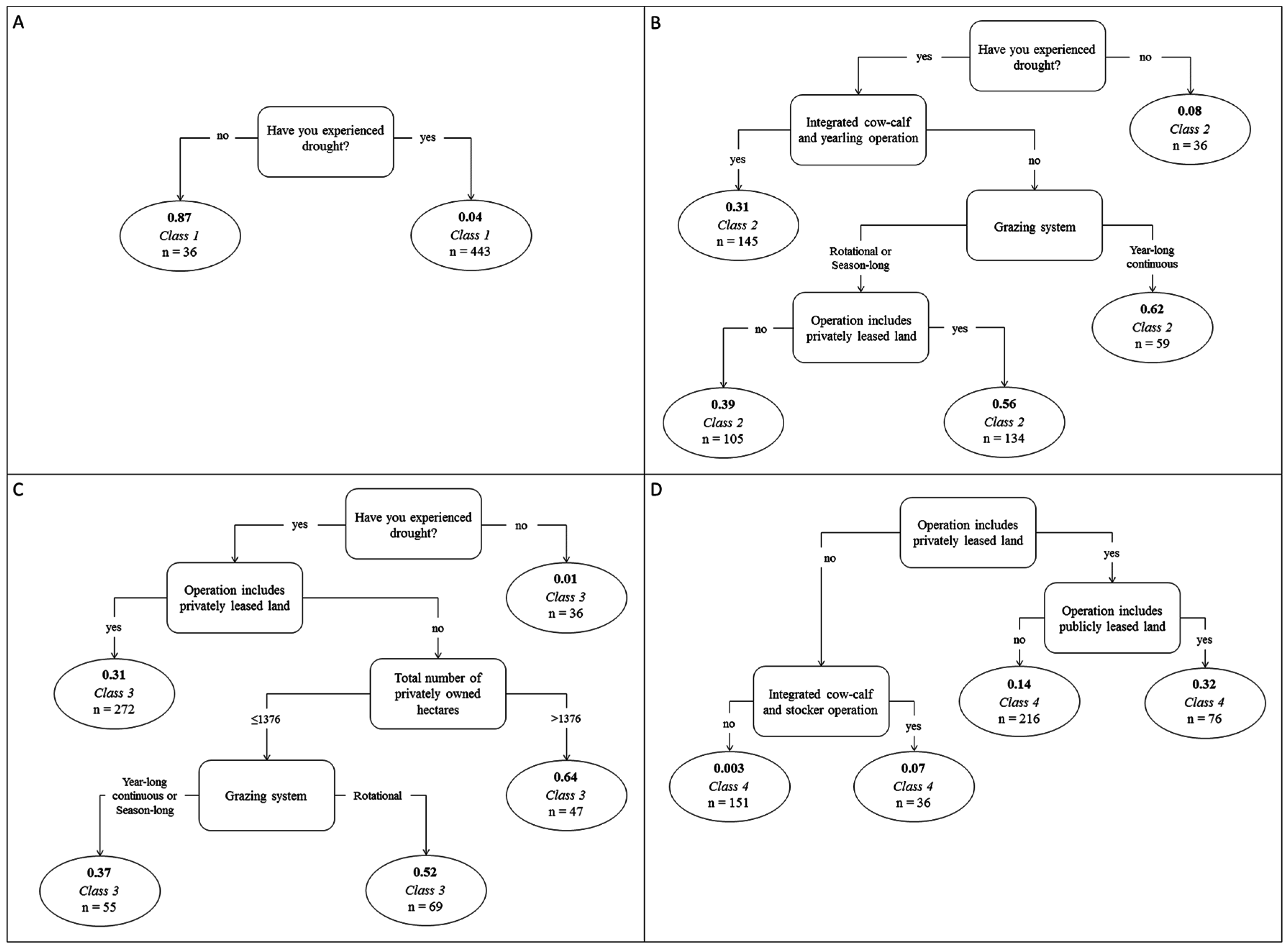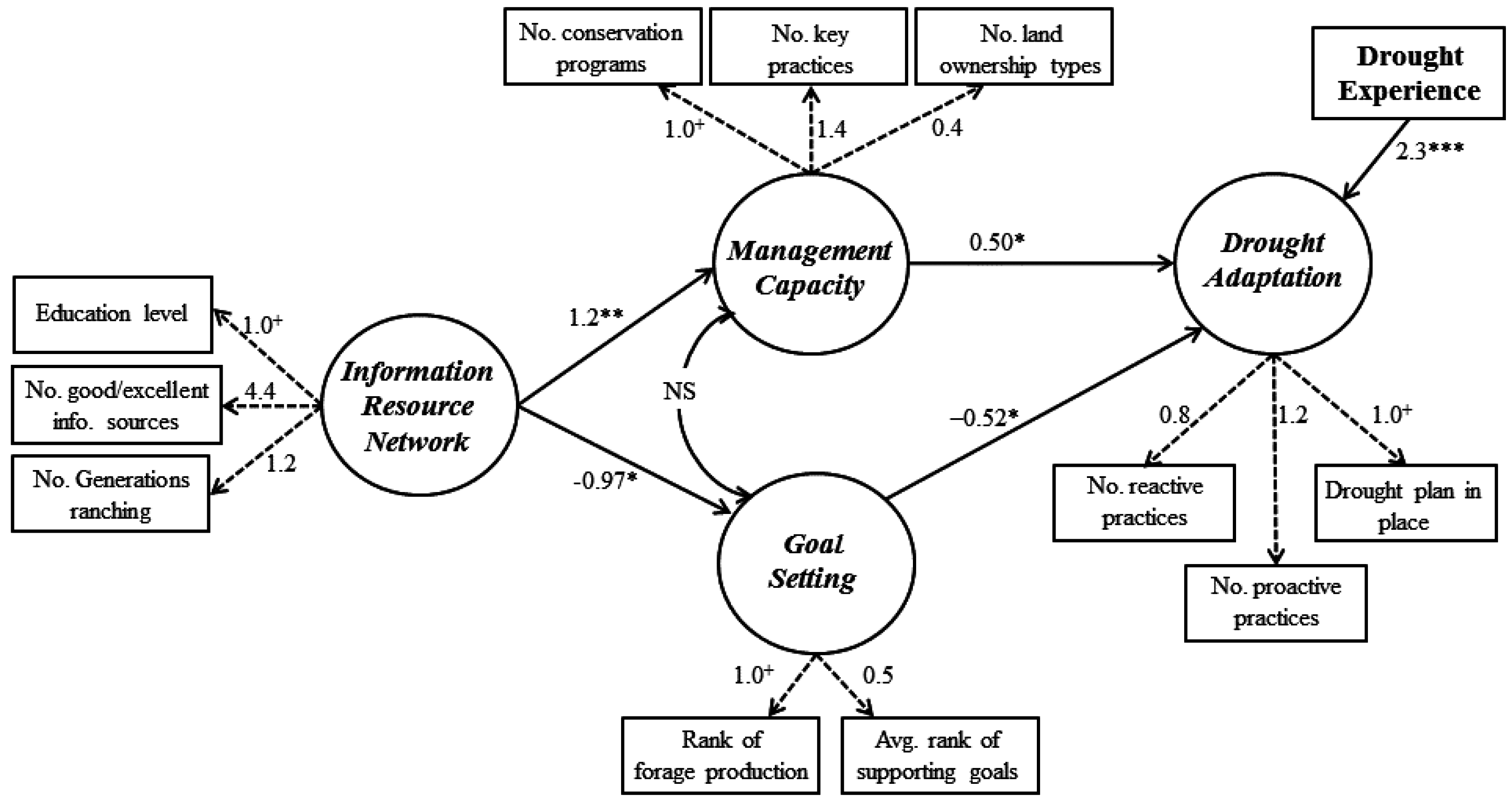Adaptive Rangeland Decision-Making and Coping with Drought
Abstract
:1. Introduction
2. Materials and Methods
2.1. Survey Design
2.2. Data Collection
2.2.1. Drought Management Practices and Strategies
2.2.2. Operation Structure
2.2.3. Information Sources
2.2.4. Operator Goals
2.2.5. Management Capacity
2.3. Data Analysis
2.3.1. Latent Class Analysis
2.3.2. Conditional Inference Regression Trees
2.3.3. Structural Equation Modelling
3. Results
3.1. Four Classes of Drought Strategies
3.2. Background Operation Variables Linked to Drought Strategy Class Selection
3.3. Decision-Making Factors Driving Individual Drought Adaptation
4. Discussion
5. Conclusions
Acknowledgments
Conflicts of Interest
References
- Havstad, K.M.; Peters, D.P.C.; Skaggs, R.; Brown, J.; Bestelmeyer, B.; Fredrickson, E.; Herrick, J.; Wright, J. Ecological services to and from rangelands of the United States. Ecol. Econ. 2007, 64, 261–268. [Google Scholar] [CrossRef]
- Sayre, N.F.; McAllister, R.R.J.; Bestelmeyer, B.T.; Moritz, M.; Turner, M.D. Earth stewardship of rangelands: Coping with ecological, economic, and political marginality. Front. Ecol. Environ. 2013, 11, 348–354. [Google Scholar] [CrossRef]
- Asner, G.P.; Elmore, A.J.; Olander, L.P.; Martin, R.E.; Harris, A.T. Grazing systems, ecosystem responses, and global change. Annu. Rev. Environ. Resour. 2004, 29, 261–299. [Google Scholar] [CrossRef]
- United Nations. World Population Prospects: The 2012 Revision, Highlights and Advance Tables; ESA/P/WP.228; United Nations, Department of Economic and Social Affairs, Population Division: New York, NY, USA, 2013; Available online: https://esa.un.org/unpd/wpp/publications/Files/WPP2012_HIGHLIGHTS.pdf (accessed on 14 December 2016).
- Intergovernmental Panel on Climate Change. Climate Change 2014: Synthesis Report; Cambridge University Press: Cambridge, UK, 2014. [Google Scholar]
- Intergovernmental Panel on Climate Change. Climate Change 2014—Impacts, Adaptation and Vulnerability—Contributions of Working Group II to the Fourth Assessment Report of the Intergovernmental Panel on Climate Change; Cambridge University Press: Cambridge, UK, 2014. [Google Scholar]
- Marshall, N.A.; Stokes, C.J.; Webb, N.P.; Marshall, P.A.; Lankester, A.J. Social vulnerability to climate change in primary producers: A typology approach. Agric. Ecosyst. Environ. 2014, 186, 86–93. [Google Scholar] [CrossRef]
- Walsh, J.; Wuebbles, D.; Hayhoe, K.K.J.; Kunkel, K.; Stephens, G.; Thorne, P.; Vose, R.; Wehner, M.; Willis, J.; Anderson, D.; et al. Climate Change Impacts in the United States: The Third National Assessment; U.S. Global Change Research Program: Washington, DC, USA, 2014; pp. 19–67. Available online: http://s3.amazonaws.com/nca2014/low/NCA3_Full_Report_02_Our_Changing_Climate_LowRes.pdf?download=1 (accessed on 14 December 2016).
- Roche, L.M.; Derner, J.D.; Cutts, B.B.; Lubell, M.N.; Tate, K.W. On-ranch grazing strategies: Context for the rotational grazing dilemma. Rangel. Ecol. Manag. 2015, 68, 248–256. [Google Scholar] [CrossRef]
- Roche, L.M.; Schohr, T.K.; Derner, J.D.; Lubell, M.N.; Cutts, B.B.; Kachergis, E.; Eviner, V.T.; Tate, K.W. Sustaining working rangelands: Insights from rancher decision making. Rangel. Ecol. Manag. 2015, 68, 383–389. [Google Scholar] [CrossRef]
- Wilmer, H.; York, E.; Kelley, W.K.; Brunson, M.W. “In every rancher’s mind”: Effects of drought on ranch planning and practice. Rangelands 2016, 38, 216–221. [Google Scholar] [CrossRef]
- Haden, V.; Niles, M.T.; Lubell, M.; Perlman, J.; Jackson, L.E. Global and local concerns: What attitudes and beliefs motivate farmers to mitigate and adapt to climate change? PLoS ONE 2012, 7, e52882. [Google Scholar] [CrossRef] [PubMed]
- Niles, M.T.; Lubell, M.; Haden, V.R. Perceptions and responses to climate policy risks among California farmers. Glob. Environ. Chang. 2013, 23, 1752–1760. [Google Scholar] [CrossRef]
- Guinn, J.M. Exceptional years: A history of California floods and drought. Hist. Soc. South. Calif. 1890, 1, 33–39. [Google Scholar] [CrossRef]
- California Department of Water Resources. Drought in California; California Department of Water Resources: Sacramento, CA, USA, 2012. Available online: http://www.water.ca.gov/wateruseefficiency/docs/2014/021114_Kent_Drought2012.pdf (accessed on 14 December 2016).
- Lubell, M.; Cutts, B.; Roche, L.M.; Hamilton, M.; Derner, J.D.; Kachergis, E.; Tate, K.W. Conservation program participation and adaptive rangeland decision-making. Rangel. Ecol. Manag. 2013, 66, 609–620. [Google Scholar] [CrossRef]
- Hoffman, M.; Lubell, M.; Hillis, V. Network-smart extension could catalyze social learning. Calif. Agric. 2015, 69, 113–122. [Google Scholar] [CrossRef]
- Didier, E.A.; Brunson, M.W. Adoption of range management innovations by Utah ranchers. J. Range Manag. 2004, 57, 330–336. [Google Scholar] [CrossRef]
- Kollmuss, A.; Agyeman, J. Mind the gap: Why do people act environmentally and what are the barriers to pro-environmental behaviour? Environ. Educ. Res. 2002, 8, 239–260. [Google Scholar] [CrossRef]
- Lubell, M.; Fulton, A. Local diffusion networks act as pathways to sustainable agriculture in the Sacramento River Valley. Calif. Agric. 2007, 61, 131–137. [Google Scholar] [CrossRef]
- Huntsinger, L.; Hopkinson, P. Viewpoint: Sustaining rangeland landscapes: A social and ecological process. J. Range Manag. 1996, 49, 167–173. [Google Scholar] [CrossRef]
- Rissman, A.R.; Sayre, N.F. Conservation Outcomes and Social Relations: A Comparative Study of Private Ranchland Conservation Easements. Soc. Nat. Resour. 2012, 25, 523–538. [Google Scholar] [CrossRef]
- Lubell, M.; Hillis, V.; Hoffman, M. Innovation, Cooperation, and the Perceived Benefits and Costs of Sustainable Agriculture Practices. Ecol. Soc. 2011, 16, 23. [Google Scholar] [CrossRef]
- Lai, P.H.; Kreuter, U.P. Examining the direct and indirect effects of environmental change and place attachment on land management decisions in the Hill Country of Texas, USA. Landsc. Urban Plan. 2012, 104, 320–328. [Google Scholar] [CrossRef]
- Marshall, N.A.; Smajgl, A. Understanding Variability in Adaptive Capacity on Rangelands. Rangel. Ecol. Manag. 2013, 66, 88–94. [Google Scholar] [CrossRef]
- Kachergis, E.; Derner, J.D.; Cutts, B.B.; Roche, L.M.; Eviner, V.T.; Lubell, M.N.; Tate, K.W. Increasing flexibility in rangeland management during drought. Ecosphere 2014, 5, 1–14. [Google Scholar] [CrossRef]
- Coppock, D.L.; Birkenfeld, A.H. Use of livestock and range management practices in Utah. J. Range Manag. 1999, 52, 7–18. [Google Scholar] [CrossRef]
- Dunn, B.; Smart, A.; Gates, R. Barriers to successful drought management: Why do some ranchers fail to take action? Rangelands 2005, 27, 13–16. [Google Scholar] [CrossRef]
- Dillman, D.A. Mail and Internet Surveys: The Tailored Design Method, 2nd ed.; John Wiley & Sons: Hoboken, NJ, USA, 2007. [Google Scholar]
- National Agricultural Statistics Service California Agricultural Statistics, Crop Year 2012. Available online: https://www.nass.usda.gov/Statistics_by_State/California/Publications/California_Ag_Statistics/Reports/2012cas-all.pdf (accessed on 14 December 2016).
- Ajzen, I.; Fishbein, M. Understanding Attitudes and Predicting Social Behavior; Prentice-Hall: Upper Saddle River, NJ, USA, 1980; p. 296. [Google Scholar]
- Sorice, M.G.; Haider, W.; Conner, J.R.; Ditton, R.B. Incentive structure of and private landowner participation in an endangered species conservation program. Conserv. Biol. 2011, 25, 587–596. [Google Scholar] [CrossRef] [PubMed]
- Rogers, E. Diffusion of Innovations; Free Press: New York, NY, USA, 2003; p. 576. [Google Scholar]
- Ferranto, S.; Huntsinger, L.; Getz, C.; Nakamura, G.; Stewart, W.; Drill, S.; Valachovic, Y.; DeLasaux, M.; Kelly, M. Forest and rangeland owners value land for natural amenities and as financial investment. Calif. Agric. 2011, 65, 184–191. [Google Scholar] [CrossRef]
- Lacey, J.R.; Wight, J.R.; Workman, J.P. Investment rationale for range improvement practices in Eastern Montana. J. Range Manag. 1985, 38, 2–6. [Google Scholar] [CrossRef]
- Napier, T.L.; Tucker, M.; McCarter, S. Adoption of conservation production systems in three Midwest watersheds. J. Soil Water Conserv. 2000, 55, 123–134. [Google Scholar]
- Bryce, S.A.; Omernik, J.M.; Larsen, D.P. Ecoregions—A geographic framework to guide risk characterization and ecosystem management. Environ. Pract. 1999, 1, 141–155. [Google Scholar] [CrossRef]
- Fazey, I.; Gamarra, J.G.P.; Fischer, J.; Reed, M.S.; Stringer, L.C.; Christie, M. Adaptation strategies for reducing vulnerability to future environmental change. Front. Ecol. Environ. 2010, 8, 414–422. [Google Scholar] [CrossRef]
- McAllister, R.R.J.; Smith, D.M.S.; Stokes, C.J.; Walsh, F.J. Patterns of accessing variable resources across time and space: Desert plants, animals and people. J. Arid Environ. 2009, 73, 338–346. [Google Scholar] [CrossRef]
- Linzer, D.A.; Lewis, J.B. poLCA: An R package for polytomous variable latent class analysis. J. Stat. Softw. 2011, 42, 1–29. [Google Scholar] [CrossRef]
- Hothorn, T.; Hornik, K.; Zeileis, A. Unbiased recursive partitioning: A conditional inference framework. J. Comput. Graph. Stat. 2006, 15, 651–674. [Google Scholar] [CrossRef]
- De’ath, G.; Fabricius, K.E. Classification and regression trees: A powerful yet simple technique for ecological data analysis. Ecology 2000, 81, 3178–3192. [Google Scholar] [CrossRef]
- Strobl, C.; Malley, J.; Tutz, G. An introduction to recursive partitioning: Rationale, application, and characteristics of classification and regression trees, bagging, and random forests. Psychol. Methods 2009, 14, 323–348. [Google Scholar] [CrossRef] [PubMed]
- Herr, A. Statistics for categorical surveys—A new strategy for multivariate classification and determining variable importance. Sustainability 2010, 2, 533–550. [Google Scholar] [CrossRef]
- Roche, L.M.; Latimer, A.M.; Eastburn, D.J.; Tate, K.W. Cattle grazing and conservation of a meadow-dependent amphibian species in the Sierra Nevada. PLoS ONE 2012, 7, e35734. [Google Scholar] [CrossRef] [PubMed]
- Stata Corporation. Stata Statistical Software: Release 13.1, Stata Press: College Station, TX, USA, 2013.
- Wilhite, D.A.; Sivakumar, M.V.K.; Pulwarty, R. Managing drought risk in a changing climate: The role of national drought policy. Weather Clim. Extremes 2014, 3, 4–13. [Google Scholar] [CrossRef]
- Briske, D.D.; Joyce, L.A.; Polley, H.W.; Brown, J.R.; Wolter, K.; Morgan, J.A.; McCarl, B.A.; Bailey, D.W. Climate-change adaptation on rangelands: Linking regional exposure with diverse adaptive capacity. Front. Ecol. Environ. 2015, 13, 249–256. [Google Scholar] [CrossRef]
- Brown, J.R.; Kluck, D.; McNutt, C.; Hayes, H. Assessing drought vulnerability using a socioecological framework. Rangelands 2016, 38, 162–168. [Google Scholar] [CrossRef]
- Thurow, T.L.; Thurow, A.P.; Garriga, M.D. Policy prospects for brush control to increase off-site water yield. J. Range Manag. 2000, 53, 23–31. [Google Scholar] [CrossRef]
- Kreuter, U.P.; Tays, M.R.; Conner, J.R. Landowner willingness to participate in a Texas brush reduction program. J. Range Manag. 2004, 57, 230–237. [Google Scholar] [CrossRef]
- McClaran, M.P.; Butler, G.J.; Wei, H.Y.; Ruyle, G.D. Increased preparation for drought among livestock producers reliant on rain-fed forage. Nat. Hazards 2015, 79, 151–170. [Google Scholar] [CrossRef]
- Marshall, N.A.; Stokes, C.J. Influencing adaptation processes on the Australian rangelands for social and ecological resilience. Ecol. Soc. 2014, 19, 14. [Google Scholar] [CrossRef]
- Marshall, N.A. Assessing resource dependency on the rangelands as a measure of climate sensitivity. Soc. Nat. Resour. 2011, 24, 1105–1115. [Google Scholar] [CrossRef]
- Robertson, M.; Murray-Prior, R. Five reasons why it is difficult to talk to Australian farmers about the impacts of, and their adaptation to, climate change. Reg. Environ. Chang. 2016, 16, 189–198. [Google Scholar] [CrossRef]
- Smith, M.S.; Horrocks, L.; Harvey, A.; Hamilton, C. Rethinking adaptation for a 4 degrees C world. Phililos. Trans. R. Soc. Lond. A 2011, 369, 196–216. [Google Scholar] [CrossRef] [PubMed]
- Kachergis, E.; Derner, J.D.; Roche, L.M.; Tate, K.W.; Lubell, M.; Mealor, R.; Magagna, J. Characterizing Wyoming ranching operations: Natural resource goals, management practices and information sources. Nat. Resour. 2013, 4, 45–54. [Google Scholar] [CrossRef]
- Coles, A.R.; Scott, C.A. Vulnerability and adaptation to climate change and variability in semi-arid rural southeastern Arizona, USA. Nat. Resour. Forum 2009, 33, 297–309. [Google Scholar] [CrossRef]



| Question | Value |
|---|---|
| Livestock | |
| Total number of cattle | 0–22,000 count |
| Cow-calf operation | Yes/No |
| Yearling operation | Yes/No |
| Integrated cow-calf and yearling operation | Yes/No |
| Land Base | |
| USEPA Level III Ecoregion | Categorical |
| Total number of privately owned hectares | 0–16,187 count |
| Total number of hectares | 1–2,059,852 count |
| Enterprise Structure | |
| Dependence on ranch as a source of income | 1–5 scale 1 |
| Operation includes privately owned land | Yes/No |
| Operation includes privately leased land | Yes/No |
| Operation includes publicly leased land | Yes/No |
| Management | |
| Grazing system | Categorical |
| Class of Drought Strategy 2 | |||||
|---|---|---|---|---|---|
| Proportion of Respondents 1 | Class 1 | Class 2 | Class 3 | Class 4 | |
| Drought response (reactive practices) | |||||
| Reduce Herd size | 71% | 0.08 | 0.69 3 | 0.86 | 0.91 |
| Purchase feed | 70% | 0.13 | 0.88 | 0.64 | 0.75 |
| Wean early | 40% | 0.00 | 0.40 | 0.41 | 0.72 |
| Apply for government assistance | 40% | 0.01 | 0.45 | 0.35 | 0.67 |
| Rent additional pasture | 27% | 0.02 | 0.35 | 0.00 | 1.00 |
| Move livestock to another location | 24% | 0.06 | 0.20 | 0.18 | 0.75 |
| Add off-farm income | 23% | 0.00 | 0.22 | 0.30 | 0.28 |
| Sell retained yearlings | 22% | 0.00 | 0.14 | 0.34 | 0.35 |
| Place livestock in a feedlot | 8% | 0.00 | 0.06 | 0.07 | 0.26 |
| Maintain herd size, and allow declines in livestock condition | 7% | 0.00 | 0.11 | 0.04 | 0.04 |
| Add an alternative on-farm enterprise | 4% | 0.04 | 0.03 | 0.06 | 0.06 |
| Drought preparation (proactive practices) | |||||
| Stock conservatively | 35% | 0.03 | 0.22 | 0.53 | 0.53 |
| Rest pastures | 24% | 0.00 | 0.11 | 0.41 | 0.36 |
| Incorporate cow-calf and yearling cattle in operation | 22% | 0.03 | 0.03 | 0.40 | 0.49 |
| Grass bank | 13% | 0.00 | 0.08 | 0.18 | 0.23 |
| Use weather predictions to adjust stocking rates | 11% | 0.00 | 0.05 | 0.19 | 0.18 |
| Add other livestock types | 3% | 0.00 | 0.00 | 0.06 | 0.05 |
| Drought Strategy Class | Respondents Assigned (%) | Mean Total Land Area (ha) | Mean Number of Cow/Calf | Mean Number of Yearlings | Mean Total Number of Cattle |
|---|---|---|---|---|---|
| 1 | 10 | 1332 | 141 | 194 | 343 |
| 2 | 42 | 2887 | 220 | 188 | 412 |
| 3 | 36 | 6421 | 323 | 321 | 644 |
| 4 | 12 | 55,184 | 645 | 833 | 1482 |
© 2016 by the author; licensee MDPI, Basel, Switzerland. This article is an open access article distributed under the terms and conditions of the Creative Commons Attribution (CC-BY) license (http://creativecommons.org/licenses/by/4.0/).
Share and Cite
Roche, L.M. Adaptive Rangeland Decision-Making and Coping with Drought. Sustainability 2016, 8, 1334. https://doi.org/10.3390/su8121334
Roche LM. Adaptive Rangeland Decision-Making and Coping with Drought. Sustainability. 2016; 8(12):1334. https://doi.org/10.3390/su8121334
Chicago/Turabian StyleRoche, Leslie M. 2016. "Adaptive Rangeland Decision-Making and Coping with Drought" Sustainability 8, no. 12: 1334. https://doi.org/10.3390/su8121334
APA StyleRoche, L. M. (2016). Adaptive Rangeland Decision-Making and Coping with Drought. Sustainability, 8(12), 1334. https://doi.org/10.3390/su8121334





